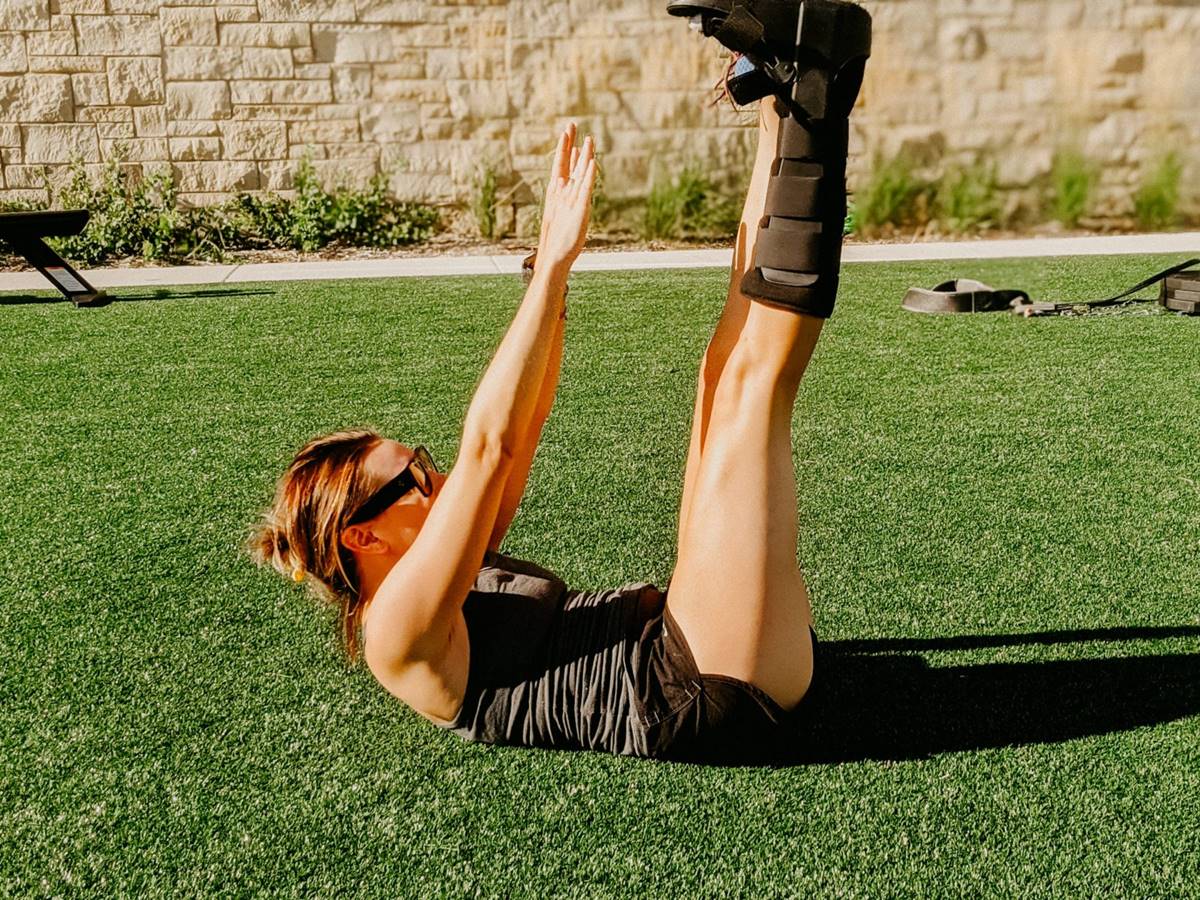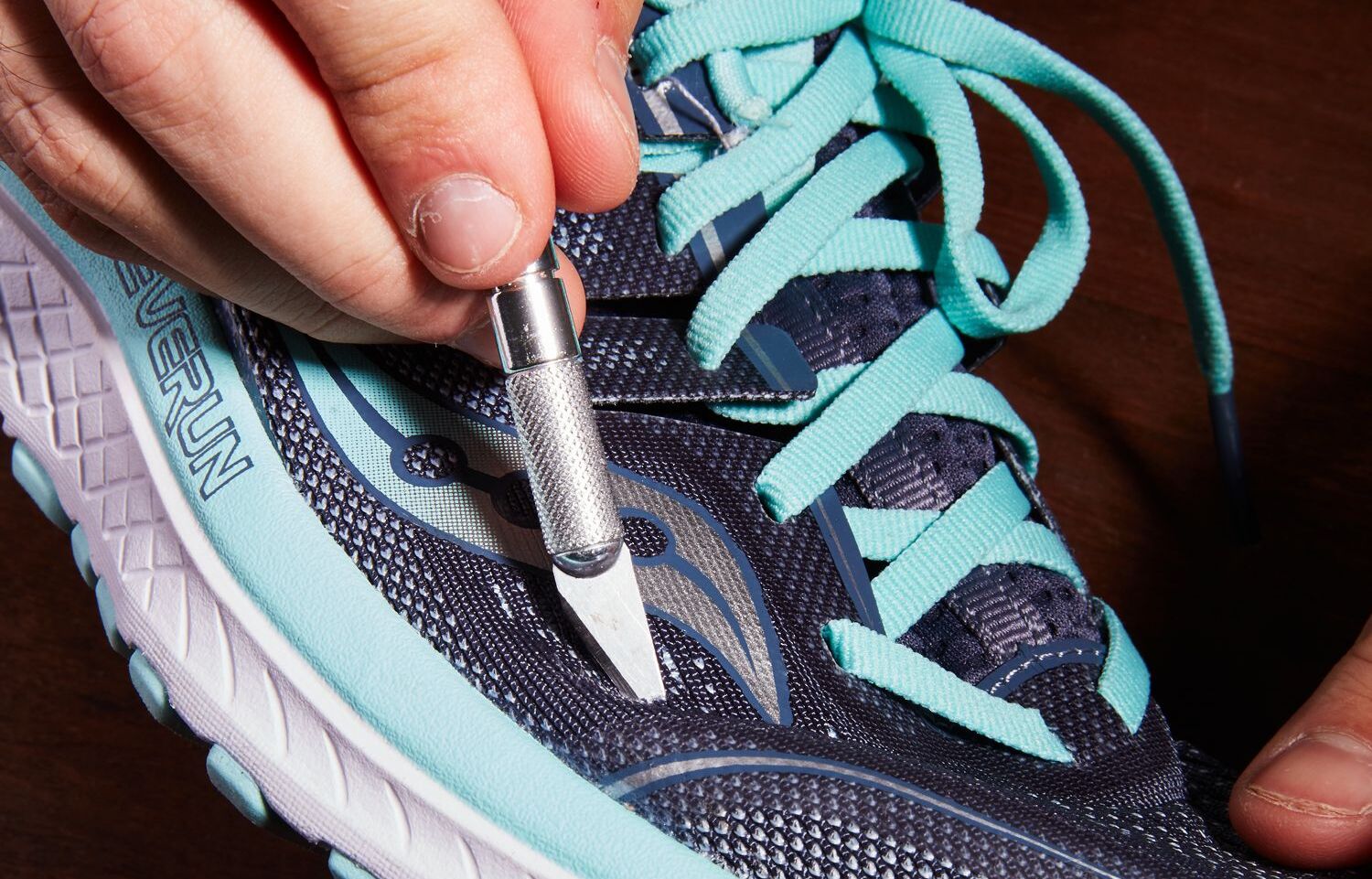

Featured
How To Exercise With A Broken Foot
Published: September 27, 2023
Learn how to stay active and maintain your fitness routine with a broken foot. Our featured exercises and tips will help you exercise safely and speed up your recovery.
Introduction
Exercising is an essential part of a healthy lifestyle, but what happens if you find yourself with a broken foot? A broken foot can be a challenging and frustrating injury that can limit your mobility and hinder your ability to engage in physical activities. However, it doesn’t mean that you have to completely press pause on your exercise routine. With the right precautions and modifications, you can still maintain your fitness level and even promote healing while working around your injury.
It’s important to understand that exercising with a broken foot requires careful consideration and consultation with a healthcare professional. Every injury is unique, and your doctor or physical therapist will be able to provide guidance tailored specifically to your situation. They will assess the severity of your injury, the type of fracture, and any accompanying complications to determine what exercises are suitable for you.
In this article, we will explore the various aspects of exercising with a broken foot and discuss some safe and effective exercises you can do during your recovery period. We’ll also provide tips and modifications to help you make the most out of your workout while ensuring you are not putting additional strain on your injured foot.
Remember, this article is meant to provide general information and guidance. It’s crucial to consult with a healthcare professional before attempting any exercises to ensure they are appropriate for your specific condition. Let’s dive in and discover how you can stay active and maintain your fitness despite a broken foot.
Understanding the Injury
Before diving into exercise options, it’s important to have a basic understanding of what happens when you have a broken foot. A broken foot, also known as a foot fracture, occurs when one or more of the bones in your foot break or crack. It can happen due to a fall, a sudden impact, or repetitive stress on the foot. Common symptoms of a broken foot include pain, swelling, bruising, difficulty bearing weight, and limited mobility.
There are several types of foot fractures, ranging from stress fractures, which are small cracks in the bones caused by overuse or repetitive stress, to more severe fractures where the bones may completely break or become displaced. The location and severity of the fracture will determine the appropriate treatment and recovery process.
In some cases, a broken foot may require immobilization in a cast, walking boot, or using crutches to relieve weight-bearing pressure. This immobilization is necessary for the bones to heal properly and prevent further damage. It’s essential to follow the treatment plan prescribed by your healthcare professional to ensure a successful recovery.
Exercise can play a significant role in your recovery process by maintaining muscle strength, improving joint mobility, and promoting circulation, but it’s crucial to approach it with caution. Pushing yourself too hard or engaging in the wrong types of exercise can worsen your injury or hinder the healing process.
Next, we’ll delve into the importance of consulting with a healthcare professional to determine the best course of action for exercising safely with a broken foot.
Consulting with a Healthcare Professional
When dealing with a broken foot, it is crucial to consult with a healthcare professional before implementing any exercise routine. Your doctor or physical therapist will have the necessary knowledge and expertise to evaluate your injury and provide appropriate recommendations.
During your consultation, your healthcare professional will assess the severity of your fracture, review any X-rays or imaging tests, and take into consideration your overall health and fitness level. They will provide you with specific guidelines on which exercises are safe to perform, taking into account any weight-bearing restrictions or limitations you may have.
It’s important to be honest and open with your healthcare professional about your exercise habits and goals. They will be able to provide tailored advice and modifications to suit your needs. They may also refer you to a physical therapist who can guide you through a structured exercise program that supports the healing process.
In addition to recommending appropriate exercises, your healthcare professional may discuss other treatment options such as physical therapy, electromagnetic therapy, or ultrasound therapy to expedite healing and reduce pain and inflammation.
Remember, every fracture is unique, and what works for one person may not be suitable for another. Following the guidance and recommendations of your healthcare professional is crucial to prevent further injury and promote optimal healing.
Safety Precautions Before Exercising with a Broken Foot
Exercising with a broken foot requires extra caution to ensure that you do not exacerbate your injury or hinder the healing process. Before you begin any exercise routine, it’s important to take the following safety precautions:
- Consult with a healthcare professional: As mentioned earlier, consulting with a healthcare professional is crucial for determining the right exercises and modifications based on your specific injury. They will provide guidance on when it is safe to start exercising, what types of exercises to avoid, and any weight-bearing restrictions.
- Listen to your body: Pay close attention to any pain or discomfort during and after exercise. Pain is your body’s way of signaling that something is wrong. If you experience increasing pain or any new symptoms, stop the exercise and consult with your healthcare professional.
- Start slow and gradually increase intensity: Begin with gentle exercises and slowly progress as your foot heals. Trying to do too much too soon can delay the healing process and potentially lead to further injury.
- Use proper footwear: Investing in a supportive shoe or wearing a walking boot recommended by your healthcare professional is essential for providing stability and protecting your injured foot during exercise.
- Avoid high-impact activities: Activities such as running, jumping, or any exercises that put excessive pressure on your foot should be avoided to prevent further damage or fractures.
- Warm up and cool down: Prioritize a proper warm-up and cool-down routine to prepare your body for exercise and gradually return it to a resting state. This helps reduce the risk of injury and muscle soreness.
- Modify and adapt exercises: Make necessary modifications to exercises to accommodate your injury. This may involve performing exercises seated or using resistance bands or weights to engage the muscles without putting strain on your foot.
- Stay hydrated: Drink plenty of water before, during, and after exercise to help maintain good overall health and support the healing process.
By taking these safety precautions, you can ensure that your exercise routine promotes healing without compromising your recovery. Remember to always follow the guidance of your healthcare professional and listen to your body’s cues.
Recommended Exercises for a Broken Foot
While it’s essential to consult with a healthcare professional before implementing any exercise routine with a broken foot, there are some exercises that are generally safe and can help maintain strength and mobility. Here are a few recommended exercises:
- Upper Body Exercises: With a broken foot, you can focus on strengthening your upper body. Exercises such as seated dumbbell curls, overhead presses, and chest presses can be performed while seated or lying down.
- Seated Exercises for Lower Body: While you may not be able to engage in weight-bearing exercises, there are seated exercises that can help strengthen your lower body muscles. These may include seated leg extensions, seated leg curls, and seated calf raises.
- Non-weight Bearing Exercises for Lower Body: Some non-weight bearing exercises can help maintain strength and improve circulation in your lower body. These can include swimming, using a stationary bike with the injured foot secured, or using an elliptical machine with minimal resistance.
- Core Stabilization Exercises: Strengthening your core can work in conjunction with upper body exercises to improve overall stability and maintain a balanced exercise routine. Planks, seated Russian twists, and seated oblique crunches are examples of core exercises you can perform.
- Range of Motion Exercises: Gentle range of motion exercises can help improve flexibility and maintain joint mobility. Ankle circles, toe curls, and towel scrunches can be performed to prevent stiffness and promote healing.
Remember to start with low intensity and gradually increase as your foot heals. Focus on maintaining proper form and performing controlled movements. It’s important to avoid exercises that cause pain or discomfort in your broken foot.
While these exercises can be beneficial, it’s crucial to note that every individual’s injury and healing process is unique. It’s always best to follow the guidance provided by your healthcare professional or physical therapist to ensure safe and effective exercises tailored to your specific needs.
Upper Body Exercises
When you have a broken foot, focusing on upper body exercises is a great way to maintain strength and fitness. These exercises target your arms, shoulders, chest, and upper back, allowing you to stay active while giving your foot time to heal. Here are a few recommended upper body exercises:
- Seated Dumbbell Curls: Sit on a chair or bench with your feet flat on the floor. Hold a dumbbell in each hand, palms facing forward. Slowly curl the weights up towards your shoulders while keeping your elbows close to your body. Lower the weights back down with control. Repeat for the desired number of repetitions.
- Overhead Press: Sit on a chair or bench with your feet flat on the floor. Hold a dumbbell in each hand at shoulder height, palms facing forward. Push the weights overhead, fully extending your arms. Lower the weights back to shoulder level and repeat.
- Chest Press: Lie flat on a bench or the floor and hold dumbbells in each hand, elbows bent and palms facing forward. Push the weights up towards the ceiling until your arms are fully extended. Slowly lower the weights back down to the starting position and repeat.
- Bent Over Rows: Stand with your feet hip-width apart, holding a dumbbell in each hand. Hinge forward at the hips while keeping your back straight. Allow your arms to hang straight down. Pull the dumbbells up towards your chest, squeezing your shoulder blades together. Lower the weights back down and repeat.
- Push-ups: Modify traditional push-ups by performing them against a wall or using an elevated surface such as a countertop or sturdy table. Place your hands shoulder-width apart on the wall or surface, and keep your body straight. Lower yourself towards the wall, bending your elbows, and then push back up to the starting position.
These exercises can be performed with dumbbells, resistance bands, or even household objects like water bottles or cans if you don’t have access to gym equipment. Aim for 2-3 sets of 8-12 repetitions for each exercise, gradually increasing the weight or resistance as you become stronger.
Remember to maintain proper form, engage your core, and avoid straining your injured foot. If any exercise causes pain or discomfort in your foot or anywhere else, stop immediately and consult with your healthcare professional.
Keep in mind that the above exercises are just a starting point. Depending on your fitness level and the specific restrictions or recommendations from your healthcare professional, there may be other upper body exercises that are more suitable for you. Always follow their guidance for a safe and effective workout routine.
Seated Exercises for Lower Body
When you have a broken foot, weight-bearing exercises and activities may be limited. However, you can still engage and strengthen your lower body with seated exercises. These exercises target muscles in your legs and buttocks while minimizing stress on your injured foot. Here are a few recommended seated exercises for your lower body:
- Seated Leg Extensions: Sit on a chair or bench with your back supported and your feet flat on the floor. Extend one leg straight out in front of you, lifting your foot off the ground. Hold momentarily, then lower your foot back down. Repeat with the other leg. You can add ankle weights or use resistance bands for added difficulty.
- Seated Leg Curls: Sit on a chair or bench with your back supported and your feet flat on the floor. Attach an ankle weight to one leg or place a resistance band around your ankle. Bend your knee, drawing your heel towards your buttocks. Hold momentarily, then slowly lower your leg back down. Repeat with the other leg.
- Seated Calf Raises: Sit on a chair or bench with your feet flat on the floor. Lift your heels off the ground, raising onto your toes. Hold momentarily at the top, then lower your heels back down. You can add extra challenge by holding dumbbells on your thighs or using a resistance band around the top of your feet.
- Seated Glute Squeezes: Sit on a chair or bench with your feet flat on the floor. Squeeze your glute muscles tightly and hold for a few seconds, then release. Repeat this squeezing motion for a set number of repetitions. This exercise helps strengthen your glute muscles without putting pressure on your broken foot.
- Seated Bicycle Crunches: Sit on a chair or bench with your hands behind your head. Bend one knee and bring it up towards your chest, simultaneously twisting your upper body to bring your opposite elbow towards the knee. Alternate sides in a cycling motion. This exercise engages your abdominal muscles and can be performed without any impact on your foot.
Performing these seated exercises regularly can help maintain muscle strength, promote circulation, and prevent muscle atrophy in your lower body. Aim for 2-3 sets of 10-15 repetitions for each exercise, gradually increasing the intensity or resistance as you progress.
Always focus on maintaining proper form, breathe rhythmically throughout each exercise, and avoid overexertion or straining your injured foot. If you experience any pain or discomfort, stop immediately and consult with your healthcare professional.
Remember, these exercises are just a starting point. Your individual injury and recovery requirements may vary, so it’s important to consult with your healthcare professional or physical therapist to ensure you are performing the most appropriate exercises for your specific situation.
Non-Weight Bearing Exercises for Lower Body
When you have a broken foot, weight-bearing exercises can be challenging or even impossible. However, there are still ways to engage your lower body and maintain strength and mobility with non-weight bearing exercises. These exercises allow you to work your leg muscles without putting any pressure on your injured foot. Here are a few recommended non-weight bearing exercises for your lower body:
- Swimming: Swimming is a fantastic non-weight bearing exercise that engages your entire body, including your legs. It helps improve cardiovascular fitness, flexibility, and overall strength. Kick your legs using a kickboard or incorporate different swimming strokes to target different muscle groups.
- Stationary Bike: Using a stationary bike allows you to engage your lower body muscles without putting stress on your foot. Adjust the seat height to ensure proper leg extension, and pedal at a comfortable pace. Increase resistance gradually as your strength improves.
- Elliptical Machine: The elliptical machine provides a low-impact workout that mimics the natural motion of walking or running without putting strain on your foot. Set the machine to a low resistance level and pedal with your feet secured on the pedals. Make sure to maintain proper posture and engage your leg muscles as you move.
- Seated Rowing Machine: The seated rowing machine is a great way to work your legs and engage your upper body. Sit on the machine with your feet strapped in. Push off with your legs and pull the handle towards your body to simulate rowing. This exercise strengthens your legs, core, and upper body.
- Resistance Band Exercises: Using resistance bands can provide effective resistance training for your lower body. Sit on a chair or bench and secure the resistance band around your feet. Perform exercises such as seated leg extensions, seated leg curls, or seated abductions to target different muscle groups.
These non-weight bearing exercises offer a safe and effective way to maintain strength, improve cardiovascular fitness, and prevent muscle atrophy in your lower body. Aim for 20-30 minutes of exercise, 3-4 times per week, gradually increasing the intensity as your fitness level progresses.
Always prioritize proper form, listen to your body, and avoid any exercises that cause pain or discomfort. If needed, consult with your healthcare professional or physical therapist to ensure you are performing the most appropriate exercises for your specific situation.
Remember, while these exercises are generally safe, it’s important to consider your own injury and consult with a healthcare professional to determine which exercises are suitable for you based on the type and severity of your broken foot.
Modifications and Alternatives for Common Exercises
When you have a broken foot, you may need to modify or find alternatives to common exercises to accommodate your injury and ensure a safe and effective workout. It’s important to work closely with your healthcare professional or physical therapist to determine which modifications are appropriate for your specific situation. Here are some common exercises and their possible modifications:
- Squats: Traditional squats require weight-bearing on both feet. If standing is not possible, you can try seated squats instead. Sit on a chair or bench, cross your arms over your chest, and push through your heels to stand up partially, then sit back down. This engages your leg muscles without putting strain on your injured foot.
- Lunges: Lunges involve stepping forward or backward with one leg while bending both knees. To modify, you can perform static lunges or stationary split squats while holding onto a stable surface for support. This allows you to work your legs without risking further injury to your foot.
- Deadlifts: Deadlifts involve lifting weight from the ground while maintaining proper form. With a broken foot, traditional deadlifts may not be feasible. Instead, you can try stability ball hamstring curls or seated cable leg curls to target your hamstrings and glutes while maintaining a seated position.
- Calf Raises: Calf raises typically require standing up on your toes and then lowering your heels. To modify this exercise, you can perform seated calf raises. Sit on a chair or bench with your feet flat on the floor, and lift your heels off the ground as much as you can.
- Planks: Planks are an effective exercise for core stabilization. If placing weight on your injured foot is not an option, you can try modified planks on your forearms and knees. Focus on engaging your core muscles and maintaining a straight line from your head to your knees.
These modifications allow you to still target the intended muscles and maintain strength while accommodating your broken foot. It is important to listen to your body and avoid any exercises that cause pain or discomfort. Remember that these modifications may not be suitable for everyone, and it’s essential to consult with your healthcare professional to determine the best approach for your specific injury.
There may also be alternative exercises that you can incorporate into your routine based on your healthcare professional’s guidance. They may suggest using resistance bands or performing specific exercises that promote muscle activation without putting stress on your foot. It’s crucial to follow their recommendations to ensure a safe and effective workout.
Tips for an Effective Workout with a Broken Foot
Exercising with a broken foot requires extra attention and care to ensure that you have an effective workout while promoting healing and avoiding further injury. Here are some tips to consider when exercising with a broken foot:
- Follow your healthcare professional’s advice: Always consult with your healthcare professional or physical therapist and follow their recommendations regarding exercise intensity, duration, and specific exercises that are safe for your injury.
- Gradually increase intensity: Start with low-intensity exercises and gradually increase the intensity as your foot heals and your strength improves. Push yourself within a comfortable range without causing pain or discomfort.
- Focus on non-impact exercises: Choose exercises that are non-weight bearing or low-impact to minimize strain on your broken foot. Swimming, stationary biking, and using the elliptical machine can be excellent options for cardiovascular fitness without risking further damage to your foot.
- Modify and adapt exercises: Modify exercises to accommodate your injury. This may involve performing seated versions of leg exercises, using resistance bands instead of weights, or incorporating non-weight bearing variations of common exercises.
- Engage in upper body and core exercises: While your lower body may be limited, focusing on upper body and core exercises can still provide an effective workout. Use this time to strengthen your upper body and maintain overall strength and fitness.
- Listen to your body: Pay close attention to any pain, discomfort, or swelling during and after exercise. If an exercise causes pain or worsens symptoms, stop immediately. Rest and consult with your healthcare professional before continuing.
- Stay consistent: Stick to a regular exercise routine to maintain strength, prevent muscle atrophy, and promote healing. Consistency is key, but always balance it with proper rest and recovery.
- Stay hydrated and nourished: Proper hydration and nutrition are essential for optimal healing. Drink plenty of water, eat a balanced diet with sufficient protein, and consume foods rich in vitamins and minerals to support your body’s recovery process.
- Use proper footwear and support: Invest in supportive footwear or use a walking boot recommended by your healthcare professional. This will provide stability and protect your injured foot during exercise.
- Stay positive and patient: Recovering from a broken foot takes time, so be patient with yourself. Maintain a positive mindset and focus on what you can do in your workout rather than dwelling on limitations.
Remember, every injury is unique, and what works for one person may not work for another. It’s important to consult with your healthcare professional or physical therapist to design a personalized exercise routine that aligns with your recovery goals and limits the risk of further injury.
By following these tips, you can have an effective and safe workout routine while allowing your foot to heal properly.
Conclusion
Exercising with a broken foot may seem challenging, but with the right approach and guidance, it is possible to maintain your fitness and promote healing. It’s crucial to consult with a healthcare professional or physical therapist to determine the best course of action based on your specific injury and recovery requirements.
Understanding the nature of your injury and the importance of consulting with a healthcare professional is the first step. They will provide you with valuable advice on safe exercises, modifications, and alternatives. Safety precautions such as listening to your body, starting slow, and using proper footwear are essential to prevent further injury and promote an effective workout.
Recommended exercises for a broken foot include upper body exercises, seated exercises for the lower body, and non-weight bearing exercises. These exercises help maintain strength, mobility, and cardiovascular fitness during your recovery period.
Modifications and alternatives for common exercises can be implemented to accommodate your broken foot. Working with resistance bands, performing seated versions of exercises, and focusing on core and upper body movements offer effective and safe alternatives.
Finally, incorporating tips such as gradually increasing intensity, staying consistent, and staying hydrated will ensure you have an effective workout while promoting healing and overall well-being.
Remember, everyone’s healing process is unique, and it’s crucial to consult with a healthcare professional to guide your exercise routine. By following their advice and being mindful of your body, you can safely navigate through your recovery and maintain your fitness level until you fully regain mobility in your foot.
With patience, dedication, and the right precautions, you can remain active and make progress towards your fitness goals even with a broken foot.









